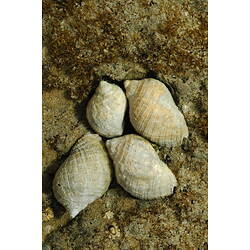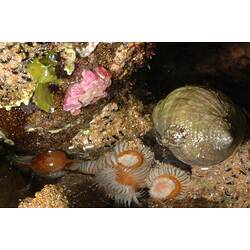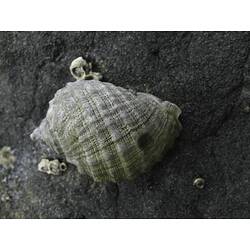General Description
Adult shell white with a short pointed end (spire); juveniles often brown. Eastern form has rough ridges around the shell, which in the western and southern forms are broken up into discontinuous lumps. Aperture cream, often with a yellow stripe around internal edge. Shell up to 10 cm long.
Biology
Dog Winkles feed on mussels, barnacles and other snails by drilling a hole in the shell, through which they extract the soft body. These holes can be differentiated from those made by predatory Moon Snails as they are straight-sided rather than countersunk. They can live for 20 years. Dog Winkles were once thought to be more than one species due to the variation in shell shape and ornamentation. It is now considered to be one species that varies due to environmental variation, including diet, temperature, and how much wave action a population is exposed to.
Distribution
Southern mainland Australia and Tasmania.
Habitat
In crevices on rock platforms and rocky reefs, to depths greater than 10 m.
More Information
-
Animal Type
-
Animal SubType
-
Brief Id
Ridges or nodes around shell.
-
Colours
White, Grey
-
Habitats
-
Diet
Carnivore
-
Diet Categories
Sea snails, Bivalves
-
Endemicity
-
Commercial
No
-
Conservation Statuses
CITES: Not listed, FFG Threatened List: Not listed, DSE Advisory List: Not listed, IUCN Red List: Not listed
-
Depths
Shore (0-1 m), Shallow (1-30 m)
-
Water Column Locations
On or near seafloor
-
Taxon Name
-
Scientific Author
(Gmelin, 1791)
-
Common Name
Dog Winkle
-
Other Names
Cart-wheel Purple , Cartrut Shell
-
Phylum
-
Subphylum
-
Superclass
-
Class
-
Subclass
-
Superorder
-
Order
-
Suborder
-
Infraorder
-
Superfamily
-
Family
-
Subfamily
-
Genus
-
Species Name
orbita




